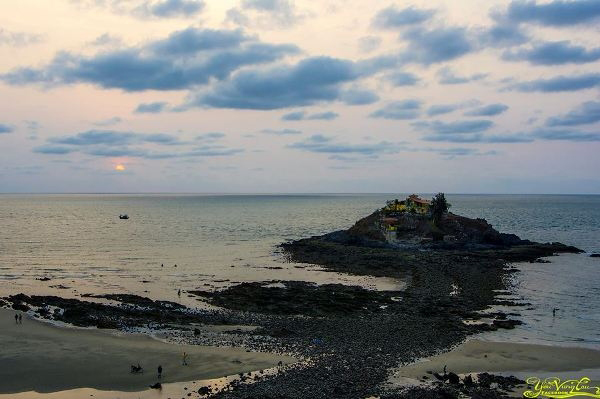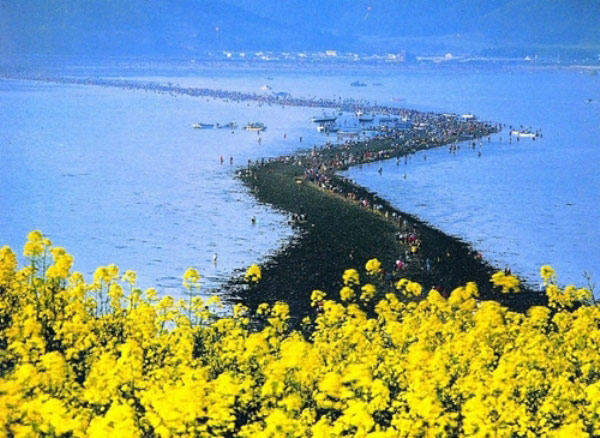3 'mysterious roads' under the sea
This strange phenomenon only appears when the tide recedes, the deep hidden roads in the sea appear as in legend creating spectacular spectacle.
Discover strange phenomena at low tide
1. Hon Ba, Vietnam
Hon Ba is the place where this strange phenomenon is believed to occur. This is a small island with an area of about 5,000m2, located in the waters of Bai Sau (Vung Tau City), about 200 m from Nghinh Phong Cape, is a beautiful landscape. On Hon Ba island is a temple (also called Hon Ba temple). For residents of Ba Ria - Vung Tau and other provinces such as: TP. Ho Chi Minh, Dong Nai, Tay Ninh, Can Tho, Tra Vinh, Vinh Long . Hon Ba temple is a spiritual address for worship and hope for many years.

The strange phenomenon appeared that attracted the curiosity of tourists
The days of water are full, tourists can go to boats, take a boat to visit the temple, but more interesting is the feeling of walking to the island. On the 14th and 15th day of the lunar month, the deep tide in the afternoon, a bumpy stone road revealed , the pilgrim visiting the temple could send a car in Thuy Van beach to walk down the beach toward the foot of the slope. Nghinh Phong and follow the stone path to Hon Ba temple. The union was crowded but not crowded, everyone seemed to be let go of the frustrations, worrying about how to be gentle and respectful when visiting the temple.
2. Strange phenomenon in the Korean island of Jindo
Many people, when referring to the famous sea crossing, immediately thought of the " divine" to find the Holy land of the Jews led by the prophet Moses. In the legend, when pursued by the Egyptian army, Moses used his power to create a dirt road through the Red Sea to rescue his people.
 Every year, when the tide drops to a certain level, this strange phenomenon will occur
Every year, when the tide drops to a certain level, this strange phenomenon will occur
So far, many people still think that such paths appear only in myths. The reality has proved the opposite: there is a place like this in the world.
It is a large rocky road connecting the two islands of Jindo and Modo in South Korea and the phenomenon of sea splitting into a mysterious and fascinating pair. On some days of the year, when the tide is extremely low, the waters between the islands of Jindo and Modo in Korea split in half, revealing the road connecting the two islands. This vast open ocean road takes most of the time of the year to sleep under the deep ocean.
However, every two to three times a year (usually around March and June), it rises to the surface and becomes the most popular tourist attraction in Korea. According to the local people, the road is about 2.9 km long and about 40 m wide.
In the days when the sea splits into half to reveal the road between the sea, it welcomes hundreds of thousands of visitors. They went together on a strange road, leisurely watching the scenery, taking souvenir photos or even catching oysters, snails, seaweed . without fearing that the road was falling or unforeseen. what.
See the scientific explanation of the phenomenon of "splitting sea" in Korea here.
3. Chinese Turtle Island
The phenomenal sprint phenomenon also occurred on the island in the middle of the Muodaoxi River, which flows through Longshi village in Yunyang, Chongqing. In China, turtles are considered as mascot, symbolizing longevity.The head of the turtle is only visible when the Three Gorges Dam discharges to the downstream, and the water recedes to 163 to 168 m.

Turtles are Chinese mascot species so the turtle-shaped island is very popular
At normal water level (175 m), this island is only a small spot. When the water recedes at a depth of 145 m, the rocky outcrop will be long and connected to the mainland. This phenomenon has quickly spread in recent years, accompanied by a large number of visitors to visit and photograph the island from the nearby hills.
Mr. Meng Liu, a local resident, said: 'Everyone thinks this is a testimony to the arrival of spring, and we call it a floating turtle period.'
- A severely deformed California street with no known cause
- The most twisty roads in the world
- What to do when the car meets flood?
- Safe driving techniques on flooded roads
- Close up of mysterious white foam covering the road to Japan after the earthquake
- Deadly roads
- The road is more than 6km long with 68 bends in China
- Ho Chi Minh City: Rainy, falling trees, flooded roads, burning electrical equipment
- Use asphalt to produce energy
- Toilet paper cleaning: Unbelievable effect
- Many Saigon roads are flooded with heavy tide
- Nearly 500 pedestrians died of road crossing: He built an intersection with 1-0-2
 'Fine laughs' - Scary and painful torture in ancient times
'Fine laughs' - Scary and painful torture in ancient times The sequence of numbers 142857 of the Egyptian pyramids is known as the strangest number in the world - Why?
The sequence of numbers 142857 of the Egyptian pyramids is known as the strangest number in the world - Why? History of the iron
History of the iron What is alum?
What is alum?